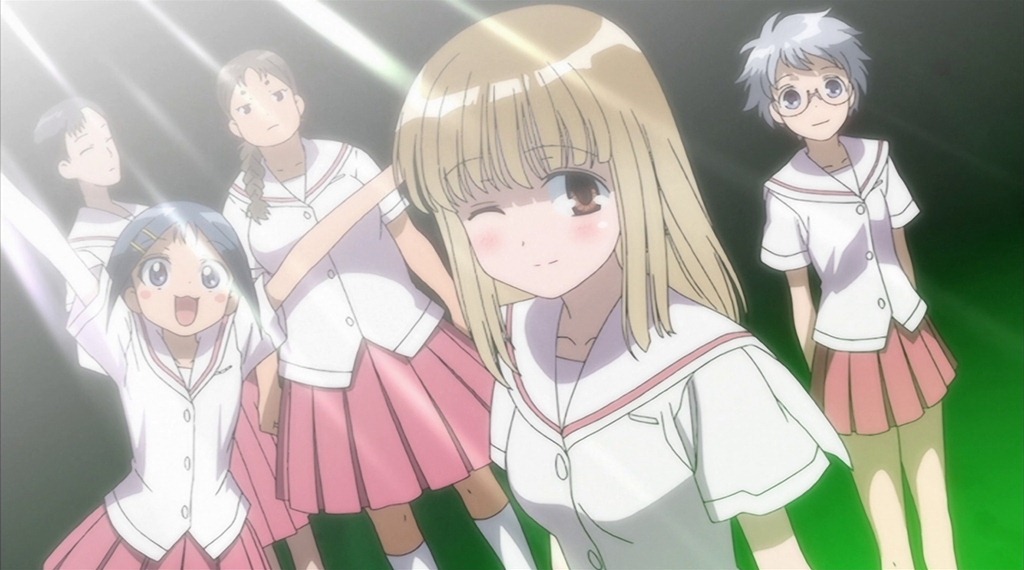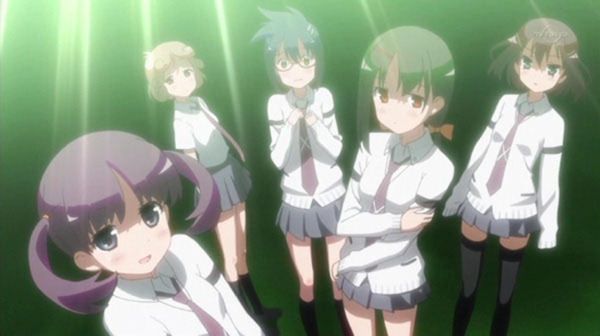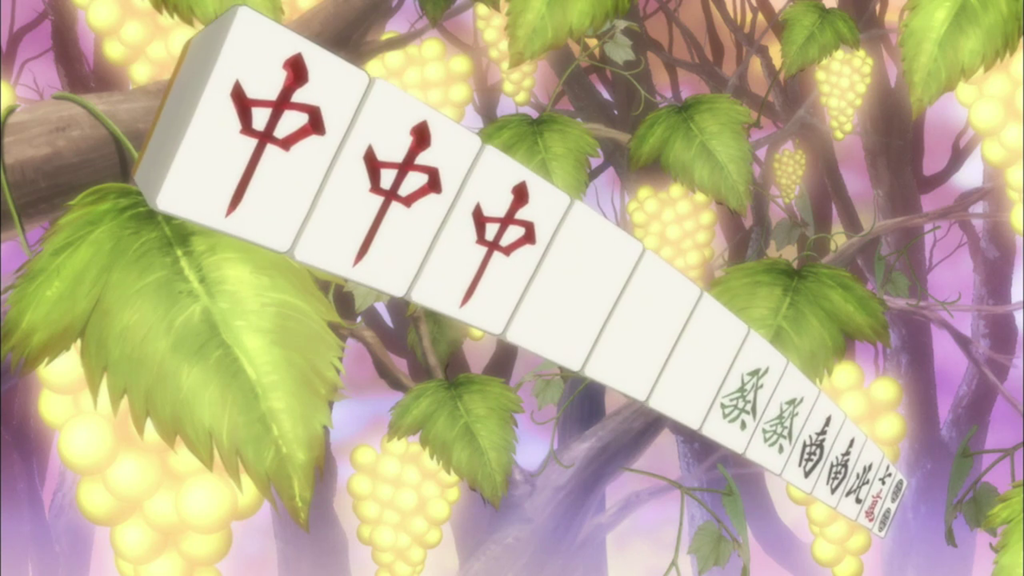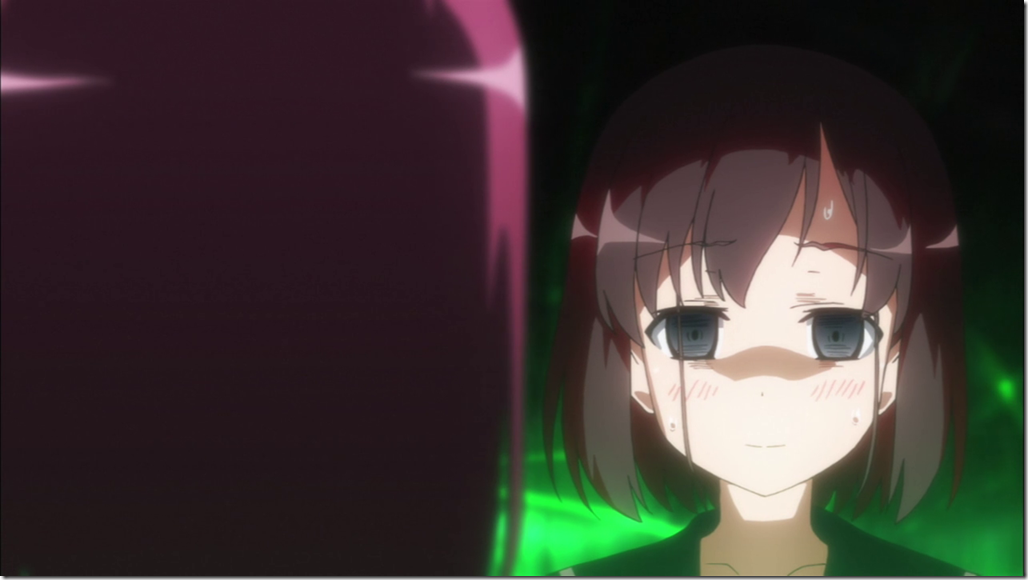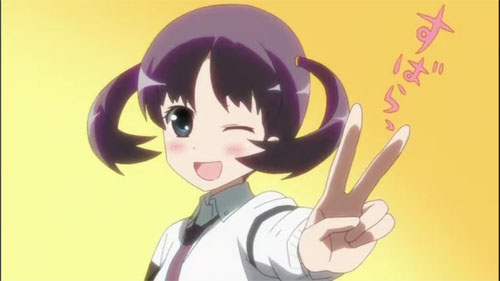Today, we’ll be delving somewhat deeper into episode 8 of Saki, Achiga-hen. As opposed to last time, we’ll have to make do with relatively few pictures of cute girls playing mahjong in this post. Instead, there’ll be plenty of mahjong tiles involved (not much of an equivalent exchange, is it?)
Today’s question is: “What was so surprising in Yumi’s play against the Matsumi sisters, and how was it an effective strategy?”

Pictured above is the hand Yumi completed in her match against the Matsumi sisters. That particular hand ended with a small but elegant ron for Kajiki, scoring 1300 points from Matsumi Kuro. Now, if you’re a mahjong amateur like me, you might get the mistaken impression that Yumi was intentionally gunning for Kuro and that changing her wait to something that the younger Matsumi sister was likely to discard was all part of the plan… but that’s not exactly the case.
First, let’s start with Yumi’s hand, pictured both below and above. The third five-bamboo tile is Yumi’s draw for the current go-around and the dora tile for the round is the two-bamboo tile (as indicated by the one-bamboo tile in the picture above).

Yumi’s hand, while nothing to write home about, at least meets the conditions for the no terminals and honors yaku, so she can go out on it without declaring riichi, which Yumi decides to do by keeping silent (so-called damaten ). In real-life mahjong, keeping silent here would also be a smart choice, as Yumi’s hand has the potential to become stronger without making significant changes to it. Drawing an additional four-bamboo, for example, gives her the two identical sequences yaku, and there’s always the two-bamboo dora tile fitting nicely into one of her sequences.
But first things first, Yumi has to decide which tile to discard at the end of her turn. And obviously, she’ll discard the eight-bamboo to get the hand pictured below, right?

This setup allows Yumi to go out on three tile types total: the 2,5 and 6 of bamboo. It also allows her to switch her wait in case she draws the four-bamboo and wants to try for the two identical sequences yaku mentioned above. Everything is just perfect.

Except, Yumi doesn’t seem to agree. She discards the six-bamboo instead, leaving herself waiting for only one tile, the seven-bamboo. (see above)

Points to consider:
Was Yumi too distracted with Momo to play Mahjong properly?
How did Yumi adapt to playing against Matsumi Yuu?
How did Yumi adapt to playing against Matsumi Kuro?

Yuu’s hand
Starting with Matsumi Yuu, we know that her ability significantly increases the probability of her drawing warm tiles and, as a result, reduces the probability of her opponents drawing warm tiles. The disruptive effect of the ability is weaker than the pull effect, as the same deviation is divided between three players, but it is by no means insignificant. Additionally, Yuu appears to have two stages to her ability that she can trigger at will: the focused and powerful one where she draws in mostly the character and red dragon tiles, and a more widespread one drawing in all kinds of warm tiles. Data for her ‘stage one’ stands out significantly, and it is possible she uses it more often than the second one, unless cornered and in need of a defensive solution.

Having access to about as much data as Senriyama’s lieutenant, Kajiki Yumi came to the same conclusion – the only way to build an effective hand against Matsumi Yuu is to give up on character tiles and make hands based on pin and bamboo tiles. Quickly discarding character tiles for a pin and bamboo combination, as seen in Yumi’s discards above, was a strategy also used by Senriyama’s second player to get around Yuu’s stage one ability.

Kuro’s hand
Kuro, on the other hand, is all her older sister is turned up to eleven. Her ability drastically improves her odds of drawing dora tiles and also eliminates the possibility of any other player drawing a dora tile. While the show’s presentation concentrates on the offensive aspect of the ability as it is easier to appreciate, the average hand value of people playing against Kuro is lower than usual thanks to the second part of her ability. Actually, against opponents playing in accordance with probability and common sense, like Nodoka, Kuro has reasonable odds of preventing them from completing their hands in the first place!
But this is where Yumi shines. The 2,5 and 6-bamboo tiles offer at most twelve tiles as opposed to the four tiles of the 7-bamboo wait. After removing the hand and discard tiles visible to Yumi, the ratio is 7:4. However, Yumi realizes the following three points:
- two-bamboo is the dora tile for the current round and it is impossible for anyone but Kuro to draw it
- the only five-bamboo tile left is the red five-bamboo, which counts as a dora and it is impossible for anyone but Kuro to draw it
- regardless of the state of her hand, Kuro will not discard any dora tile she draws
As such:
There is no possibility whatsoever that any of the five tiles will be drawn by Yumi or discarded by any player.
The actual odds for the waits are not 7:4, as it seems, but 2:4, and the ‘obviously superior choice’ is in fact a trap that is little better than a hell wait.

Surprise!
To sum up, Yumi can’t predict that Kuro will draw the seven-bamboo, much less that she will discard it. Yumi’s brilliance lies in acknowledging the disruptive effects of the Matsumi sisters’ abilities and finding the most effective moves in the abnormal probability zone the two produce, especially when together. With time, the friends and family of the Matsumi sisters probably developed habits that let them play effectively in those irregular circumstances, but Yumi proved to our heroes that top-ranked players who face Yuu and Kuro for the first time can and will adjust their playing styles based on research alone.

…and understanding.
Read Full Post »



